Power electronic handbook
Подождите немного. Документ загружается.

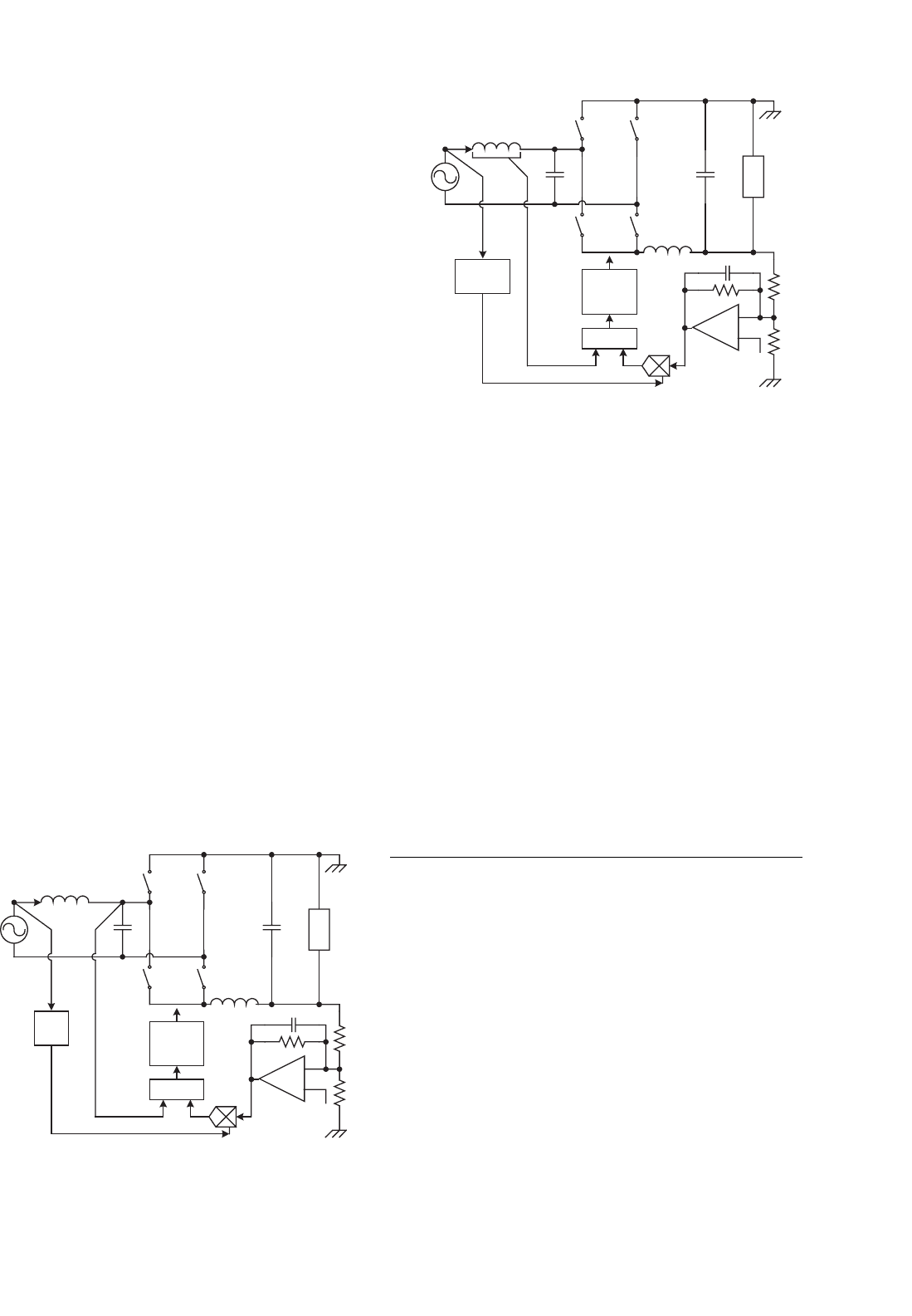
530 I. Batarseh and H. Wei
input circuit of an ac–dc converter and its phasor diagram rep-
resentation, where φ is the phase shift between the line current
and the capacitor voltage. An LC network could be added to
the input either before a switch mode rectifier (SMR) or after
a passive rectifier to perform such kind of control. In boost
type converter, the inductor L
i
is the input inductor. It can be
seen from the phasor diagram that to keep the line current in
phase with the line voltage, we can either control the capaci-
tor voltage or the inductor voltage. If the capacitor voltage is
chosen as controlled variable, the control strategy is known as
delta modulation control.
A. Capacitor Voltage Control
Figure 19.24 gives a SMR with PFC using capacitor voltage
control [36]. The capacitor voltage v
c1
(t) is forced to track a
sinusoidal command v
∗
c1
(t) signal to indirectly adjust the line
current in phase with the line voltage. The command signal is
the product of the line voltage signal with a phase shift of φ
and the feedback error signal. The phase shift φ is a function of
the magnitudes of line voltage and line current, therefore the
realization of a delta control is not really simple. In addition,
since φ is usually very small, a small change in capacitor voltage
will cause a large change in the inductor voltage, and hence in
the line current. Thus it make the circuit very sensitive to
parameter variations and perturbations.
B. Inductor Voltage Control
To overcome the above shortcomings, inductor voltage con-
trol strategies was reported in [37]. Figure 19.25 shows an
SMR with PFC using inductor voltage control. As the phase
difference between the line voltage and the inductor voltage is
fixed at 90
◦
ideally, the control circuit is simpler in implemen-
tation than that of capacitor voltage control. As the inductor
voltage is sensitive to the phase shift φ, but not sensitive to the
change in magnitude of reference, the inductor voltage control
method is more effective in keeping the line current in phase
e
jφ
Comp.
E/A
_
+
V
ref
Logic
&
Drive
Load
_
V
o
+
L
1
C
1
S
1
S
2
S
3
S
4
v
l
(t)
i
l
(t)
C
o
L
2
v
C1
(t)
v
C1
(t)
*
FIGURE 19.24 SMR using capacitor voltage control.
e
jπ/2
Comp.
E/A
_
+
V
ref
Logic
&
Drive
Load
_
V
o
+
L
1
C
1
S
1
S
2
S
3
S
4
v
l
(t)
i
l
(t)
C
o
L
2
v
L1
(t) v
L1
(t)
*
FIGURE 19.25 SMR using inductor voltage control.
with the line voltage. However, in the implementations of both
the two kinds of voltage control methods hysteresis technique
is normally used. Therefore, unlike the previous current mode
control, variable frequency problem is encountered in these
control methods.
Generally speaking, by using CCM shaping technique, the
input current can trace the wave shape of the line voltage
well. Hence the PF can be improved efficiently. However, this
technique involves in the designing of complicated control cir-
cuits. Multiloop control strategy is needed to perform input
current shaping and output regulation. In most CCM shap-
ing techniques, current sensor, and multiplier are required,
which results in higher cost in practical applications. In some
cases, variable frequency control is inevitable, resulting in addi-
tional difficulties in its closedloop design. Table 19.1 gives a
comparison among these control methods.
19.5 DCM Input Technique
To get rid of the complicated control circuit invoked by CCM
shaping technique and reduce the cost of the electronic inter-
face, DCM input technique can be adopted in low power to
medium power level application.
In DCM, the inductor current of the core converter is no
longer a valid state variable since its state in a given switch-
ing cycle is independent of the value in the previous switching
cycle [38]. The peak of the inductor current is sampling the
line voltage automatically, resulting in sinusoidal-like average
input current (line current). This is why DCM input circuit is
also called “voltage follower” or “automatic controller.” The
benefit of using DCM input circuit for PFC is that no feedfor-
ward control loop is required. This is also the main advantage
over a CCM PFC circuit, in which multiloop control strategy
is essential. However, the input inductor operating in DCM

19 Power Factor Correction Circuits 531
TABLE 19.1 Comparison of CCM shaping techniques
Average VF peak-current CF peak-current Hysteresis Charge Non-linear Capacitor Inductor
current carrier voltage voltage
Input ripple Low High High Low Low Low Low Low
Switching
frequency
Constant Variable Constant Variable Constant Constant Variable Variable
Dynamic
response
Slow Slow Slow Fast Fast Fast Fast Fast
Control signal
sensed for
inner loop
Input current
& input
voltage
Input (or switch)
current & input
voltage
Input (or switch)
current & input
voltage
Input current
& input
voltage
Input (or switch)
current & input
voltage
Input (or
switch)
current
Input voltage
& capacitor
voltage
Input voltage
& inductor
voltage
Inner loop E/A Yes No No Yes No No No No
Multiplier Yes Yes Yes Yes Yes No Yes Yes
cannot hold the excessive input energy because it must release
all its stored energy before the end of each switching cycle. As
a result, a bulky capacitor is used to balance the instantaneous
power between the input and output. In addition, in DCM, the
input current is normally a train of triangle pulses with nearly
constant duty ratio. In this case, an input filter is necessary for
smoothing the pulsating input current.
19.5.1 Power Factor Correction Capabilities of
the Basic Converter Topologies in DCM
The DCM input circuit can be one of the basic dc–dc converter
topologies. However, when they are applied to the rectified line
voltage, they may draw different shapes of average line current.
In order to examine the PFC capabilities of the basic con-
verters, we first investigate their input characteristics. Because
the input currents of these converters are discrete when they
are operating in DCM, only averaged input currents are con-
sidered. Since switching frequency is much higher than the
line frequency, let’s assume the line voltage is constant in a
switching cycle. In steady state operation, the output voltage is
nearly constant and the variation in duty ratio is slight. There-
fore, constant duty ratio is considered in deriving the input
characteristics.
A. Buck Converter
The basic buck converter topology and its input current wave-
form when operating in DCM are shown in Figs. 19.26a and b,
respectively. It can be shown that the average input current in
one switching cycle is given by
i
1,avg
(t) =
1
T
s
1
2
·DT
s
·
v
1
(t) − V
o
L
DT
s
(19.24)
=
D
2
T
s
2L
v
1
(t) −
D
2
T
s
2L
V
o
Figure 19.26c shows that the input voltage–input current
I–V characteristic consists of two straight lines in quadrants
I and III. It should be noted that these straight lines do not
go through the origin. When the rectified line voltage v
1
(t)is
less than the output voltage V
o
, negative input current would
occur. This is not allowed because the bridge rectifier will block
the negative current. As a result, the input current is zero near
the zero crossing of the line voltage, as shown in Fig. 19.26c.
Actually, the input current is distorted simply because the buck
converter can work only under the condition when the input
voltage is larger than the output voltage. Therefore, the basic
buck converter is not a good candidate for DCM input PFC.
B. Boost Converter
The basic boost converter and its input current waveform
are shown in Figs. 19.27a and b, respectively. The input I–V
characteristic can be found as follows
i
1,avg
(t) =
1
T
s
1
2
·
(
D +D
1
)
T
s
v
1
(t)
L
DT
s
(19.25)
=
D
2
T
s
2L
v
1
(t)V
o
V
o
−v
1
(t)
where, D
1
T
s
is the time during which the inductor current
decreases from its peak to zero.
By plotting Eq. (19.25), we obtain the input I–V charac-
teristic curve as given in Fig. 19.27c. As we can see that as
long as the output voltage is larger than the peak value of the
line voltage in certain range, the relationship between v
1
(t)
and i
1,avg
(t) is nearly linear. When the boost converter is con-
nected to the line, it will draw almost sinusoidal average input
current from the line, shown as in Fig. 19.27c. As one might
notice from Eq. (19.25) that the main reason to cause the non-
linearity is the existence of D
1
. Ideally, if D
1
= 0, the input
I–V characteristic will be a linear one.
Because of the above reasons, boost converter is compa-
rably superior to most of the other converters when applied
to do PFC. However, it should be noted that boost converter
can operate properly only when the output voltage is higher
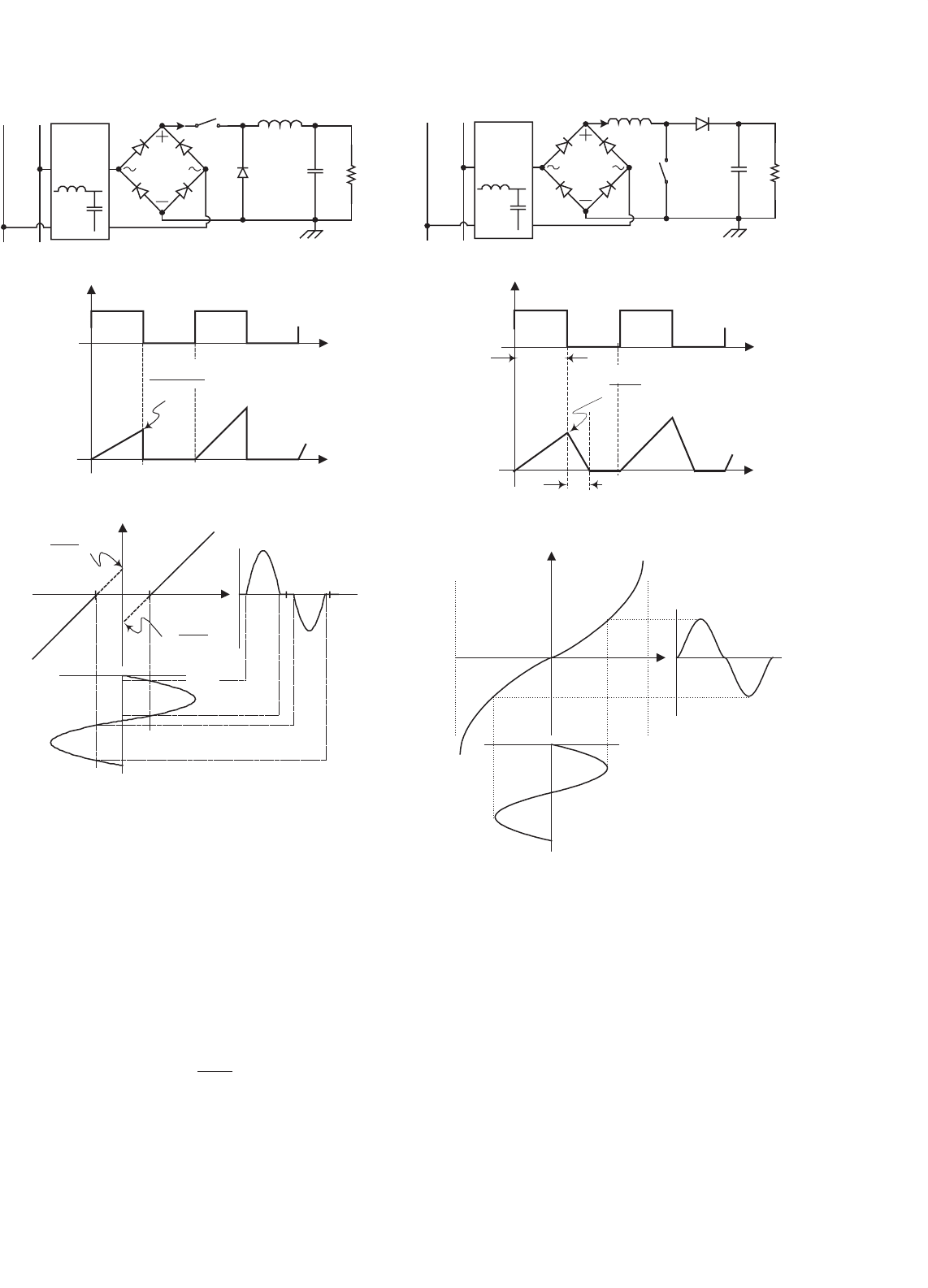
532 I. Batarseh and H. Wei
i
1
(t)
Line
L
S
+
_
C
D
R
L
V
o
Line
filter
v
1
(t)
(a)
DT
s
T
s
t
0
t
DT
s
L
i
1
(t)
S
ON OFF
ON
(b)
(c)
−V
o
V
o
V
o
L
D
2
T
s
2
V
o
D
2
T
s
2L
−
i
l
(t)
v
l
(t)
i
l
(t)
t
t
T
l
/2
T
l
v
l
(t)
v
1
(t)−V
o
FIGURE 19.26 Input I–V characteristic of basic buck converter oper-
ating in DCM: (a) buck converter; (b) input current; and (c) input I–V
characteristic.
than its input voltage. When low voltage output is needed, a
stepdown dc–dc converter must be cascaded.
C. Buck–Boost Converter
Figure 19.28a shows a basic buck–boost converter. The aver-
aged input current of this converter can be found according
to its input current waveform, shown in Fig. 19.28b.
i
1,avg
(t) =
D
2
T
s
2L
v
1
(t) (19.26)
Equation (19.26) gives a perfect linear relationship between
i
1,avg
(t) and v
1
(t), which proves that a buck–boost has an
i
1
(t)
Line
L
S
+
_
C
D
R
L
V
o
Line
filter
v
1
(t)
(a)
(b)
V
o
V
o
i
l
(t)
v
l
(t)
v
l
(t)
i
l
(t)
t
t
(c)
DT
s
T
s
t
0
t
S
ON OFF
ON
DTs
L
D
1
T
s
i
1
(t)
v
1
(t)
FIGURE 19.27 Input I–V characteristic of basic boost converter oper-
ating in DCM: (a) boost converter; (b) input current; and (c) input
I–V characteristic.
excellent automatic PFC property. This is because the input
current of buck–boost converter does not related to the dis-
charging period D
1
. Its input I–V characteristics and input
voltage and current waveforms are shown in Fig. 19.28c.
Furthermore, because the output voltage of buck–boost con-
verter can be either larger or smaller than the input voltage,
it demonstrates strong availability for DCM input technique
to achieve PFC. So, theoretically buck–boost converter is a

19 Power Factor Correction Circuits 533
i
1
(t)
Line
L
S
_
+
C
D
R
L
Line
filter
v
1
(t)
(a)
DT
s
T
s
t
0
t
DT
s
L
v
1
(t)
i
1
(t)
S
ON OFF
ON
(b)
(c)
i
l
(t)
t
t
v
l
(t)
i
l
(t)
v
l
(t)
V
o
FIGURE 19.28 Input I–V characteristic of basic buck–boost converter
operating in DCM: (a) buck–boost converter; (b) input current; and
(c) input I–V characteristic.
perfect candidate. Unfortunately, this topology has two limi-
tations: (1) the polarity of its output voltage is reversed, i.e.
the input voltage and the output voltage don’t have a com-
mon ground; and (2) it needs floating drive for the power
switch. The first limitation circumscribes this circuit into a
very narrow scope of applications. As a result, it is not widely
used.
D. Flyback Converter
Flyback converter is an isolated converter whose topology and
input current waveform are shown in Figs. 19.29a and b,
S
D
C
R
L
+
V
o
_
T
L
m
i
1
(t)
Line
Line
filter
v
1
(t)
(a)
DT
s
T
s
t
0
t
DT
s
L
m
v
1
(t)
i
1
(t)
S
ON OFF
ON
(b)
FIGURE 19.29 Input I–V characteristic of basic flyback converter
operating in DCM: (a) flyback converter and (b) input current.
respectively. The input voltage–input current relationship is
similar to that of buck–boost converter
i
1,avg
(t) =
D
2
T
s
2L
m
v
1
(t) (19.27)
where, L
m
is the magnetizing inductance of the output
transformer.
Therefore, it has the same input I–V characteristic, and
hence the same input voltage and input current waveforms
as those the buck–boost converter has, shown in Fig. 19.29c.
Comparing with buck–boost converter, flyback converter
has all the advantages of the buck–boost converter. What’s
more, input–output isolation can be provided by flyback con-
verter. These advantages make flyback converter well suitable
for PFC with DCM input technique. Comparing with boost
converter, the flyback converter has better PFC and the output
voltage can be either higher or lower than the input voltage.
However, due to the use of power transformer, the flyback con-
verter has high di/dt noise, lower efficiency, and lower density
(larger size and heavier weight).
E. Forward Converter
The circuit shown in Fig. 19.30 is a forward converter.
In order to avoid transformer saturation, it is well-known
that forward converter needs the 3rd winding to demagnetize
(reset) the transformer. When a forward converter is con-
nected to the rectified line voltage, the demagnetizing current
through the 3rd winding is blocked by the rectifier diodes.
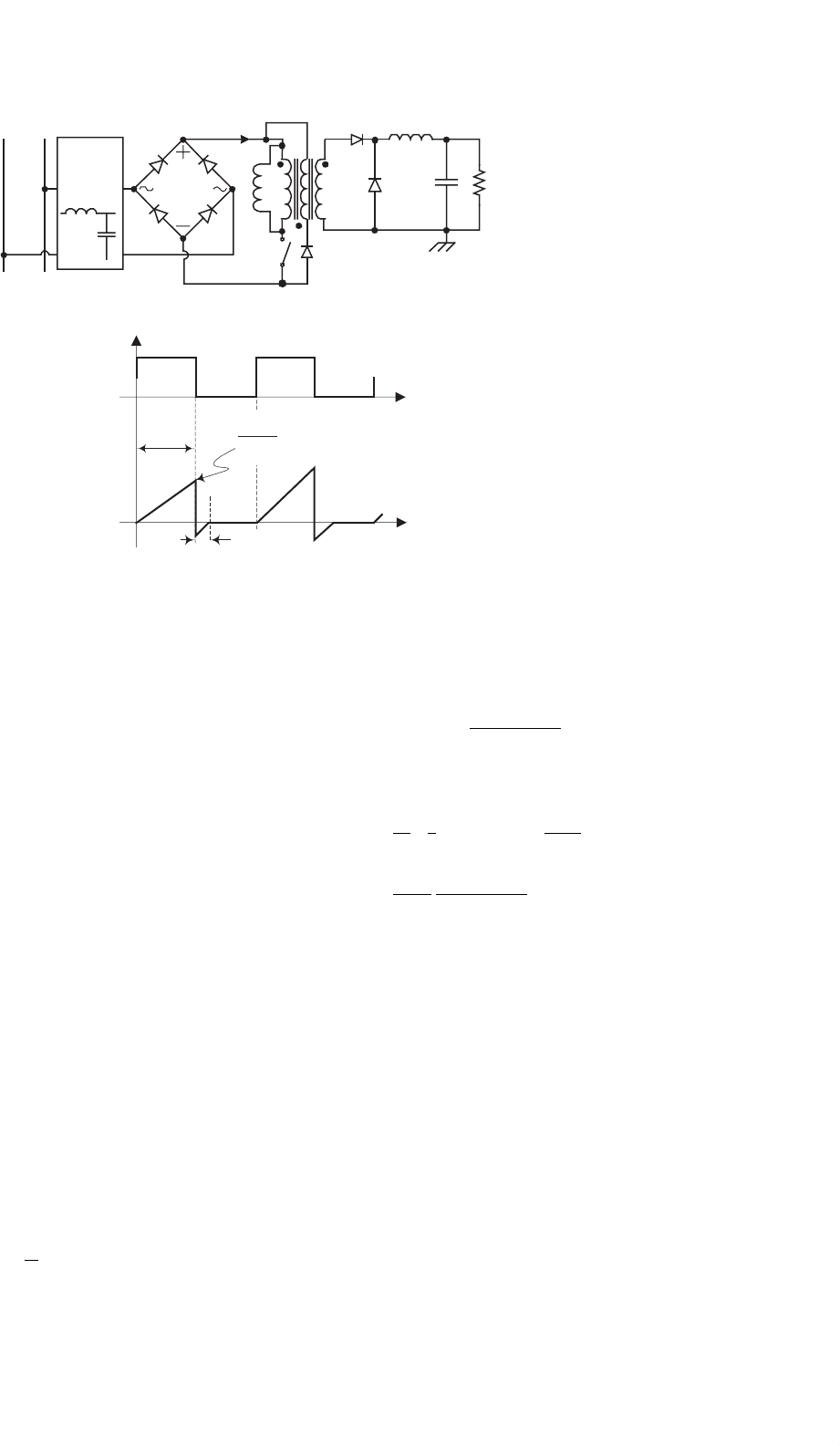
534 I. Batarseh and H. Wei
D
2
C
+
V
o
_
T
L
m
D
1
L
D
3
S
i
1
(t)
Line
Line
filter
v
1
(t)
(a)
DT
s
T
s
t
0
t
DT
s
L
m
v
1
(t)
i
1
(t)
S
ON OFF ON
D
1
T
s
(
b
)
FIGURE 19.30 (a) Forward converter and (b) input current waveform.
Therefore, forward converter is not available for PFC purpose
unless a certain circuit modification is applied.
F. Cuk Converter and Sepic Converter
It can be shown that Cuk converter and Sepic converter
given in Figs. 19.31a and b, respectively, have the same input
I–V characteristic. Each of these converter topologies has two
inductors, with one located at its input and the other at its
output. Let’s consider the case when the input inductor oper-
ates in DCM while the output inductor operates in CCM. In
this case, the capacitor C
1
can be designed with large value
to balance the instantaneous input/output power, resulting in
high PF in the input and low second harmonic ripple in the
output voltage. To investigate the input characteristic of these
converters, let’s take the Cuk converter as an example. One
should note that the results from the Cuk converter are also
suitable for Sepic converter.
For the Cuk converter shown in Fig. 19.31a, the waveforms
for input inductor current (the same as the input current),
output inductor current, and the voltage across the output
inductor are depicted in Fig. 19.31c. Assume that the capacitor
C
1
is large enough to be considered as a voltage source V
c
,in
steady state, employing volt-second equilibrium principle on
L
2
, we obtain
V
C
=
1
D
V
o
(19.28)
The input inductor current reset time ratio D
1
is given by
D
1
=
D
2
v
1
(t)
V
o
−Dv
1
(t)
(19.29)
Therefore the averaged input current can be found as
i
1,avg
(t) =
1
T
s
1
2
·
(
D +D
1
)
T
s
v
1
(t)
L
DT
s
(19.30)
=
D
2
T
s
2L
v
1
(t)V
o
V
o
−Dv
1
(t)
It can be seen that Eq. (19.30) is very similar to Eq. (19.25)
except that the denominator in the former equation is
(V
o
−Dv
1
(t)) instead of (V
o
− v
1
(t)). This will lead to some
improvement in that I–V characteristic in Cuk converter.
Referring to the I–V characteristic shown in Fig. 19.27c, Cuk
converter has a curve more close to a straight line. Such
improvement, however, is achieved at the expense of using
more circuit components. It can be proved that the same
results can be obtained by the Sepic converter.
G. Zeta Converter
Figure 19.32a gives a Zeta converter connected to the line.
In DCM operation, the key waveforms are illustrated in
Fig. 19.32b, where we presume the capacitor being equiva-
lent to a voltage source V
c
. As we can see that the converter
input current waveform is exactly the same as that drawn by a

19 Power Factor Correction Circuits 535
i
1
(t)
Line
L
1
S
−
+
DR
L
V
o
Line
filter
v
1
(t)
L
2
C
1
C
2
+ V
c
−
+ v
L2
−
i
L2
(t)
I
o
(a)
i
1
(t)
Line
L
1
S
+
_
D
R
L
V
o
Line
filter
v
1
(t)
L
2
C
1
C
2
+ V
c
−
i
L2
(t)
I
o
v
L2
+
−
(b)
DT
s
T
s
0 t
DT
s
L
1
v
1
(t)
i
1
(t)
S
ON
OFF ON
D
1
T
s
i
L2
(t)
I
o
t
t
t
v
L2
(t)
V
c
-V
o
−V
o
(c)
FIGURE 19.31 Input I–V characteristic of basic Cuk converter and
Sepic converter operating in DCM: (a) Cuk converter; (b) Sepic con-
verter; and (c) typical waveforms of Cuk converter with input inductor
operating in DCM.
buck–boost converter. Thus, the average input current for the
Zeta converter is identical to that for the buck–boost converter,
which is given by Eq. (19.26). As a result, the Zeta converter has
as good automatic PFC capability as the buck–boost converter.
The improvement achieved here is the non-inverted output
voltage. However, like the buck converter, floating drive is
required for the power switch.
Based on the above discussion, we may conclude that all
the eight basic converters except forward converter have good
inherent PFC capability and are available for DCM PFC usage.
Among them, boost converter and flyback converter are espe-
cially suitable for single-stage PFC scheme because they have
minimum component count and grounded switch drive, and
their power switches are easy to be shared with the output
i
1
(t)
Line
L
1
S
DR
L
V
o
Line
filter
v
1
(t)
L
2
C
1
C
2
+ v
L2
−− V
c
+
+
_
I
o
i
L2
(t)
(a)
DT
s
T
s
0 t
DT
s
L
1
v
1
(t)
i
1
(t)
S
ON
OFF ON
D
1
T
s
i
L1
(t)
t
t
t
v
L2
(t)
V
c
+v
1
(t)−V
o
−V
o
(b)
FIGURE 19.32 Input I–V characteristic of basic Zeta converter oper-
ating in DCM: (a) Zeta converter and (b) typical waveforms of Zeta
converter with input inductor operating in DCM.
dc–dc converter. Hence, these two converters are most prefer-
able by the designers for PFC purpose. The other converters
could also be used to perform certain function such as circuit
protection and small output voltage ripple. The characteris-
tics of the eight basic converter topologies are summarized in
Table 19.2.
19.5.2 AC–DC Power Supply with DCM
Input Technique
In two-stage PFC power supply, the DCM converter is con-
nected in front of the ac line to achieve high input PF and
provide a roughly regulated dc bus voltage, as shown in
Fig. 19.33. This stage is also known as “pre-regulator.” The
duty ratio of the pre-regulator should be maintained relatively
stable so that high PF is ensured. To stabilize the dc bus volt-
age, a bank capacitor is used at the output of the pre-regulator.
The second stage, followed by the pre-regulator, is a dc–dc
converter, called post-regulator, with its output voltage being
tightly controlled. This stage can operate either in DCM or
in CCM. However, CCM is normally preferred to reduce the
output voltage ripple.
DCM input technique has been widely used in one-
stage PFC circuit configurations. Using a basic converter
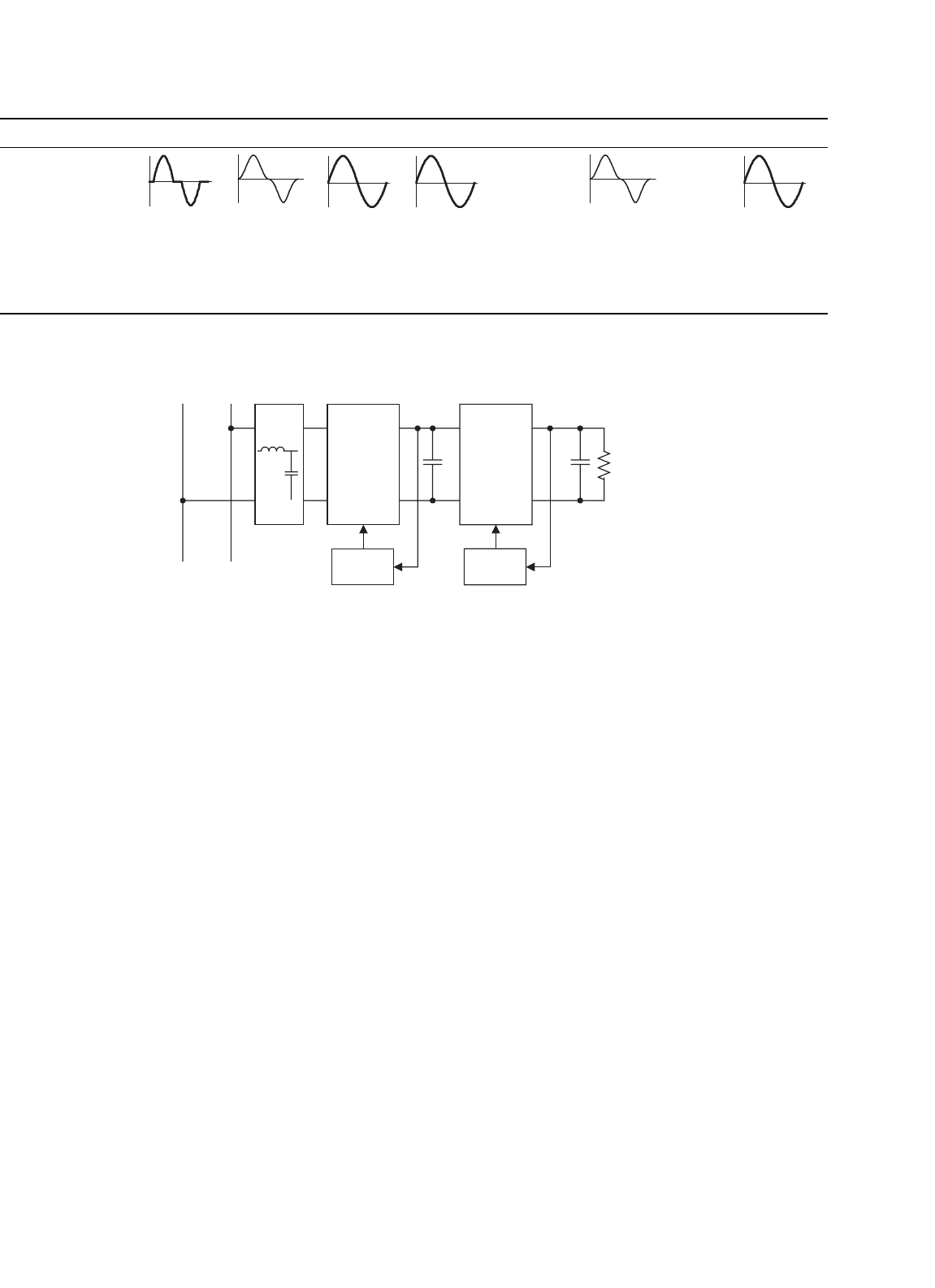
536 I. Batarseh and H. Wei
TABLE 19.2 Comparison of basic converter topologies operating for DCM input technique
Buck Boost Buck–boost Flyback Forward
∗
Cuk and sepic Zeta
Line current waveform –
Switch drive Floating Grounded Floating Grounded Grounded Grounded Floating
Peak input current High Lower High High – Lower High
Inrush and overload
protection
Yes No Yes Yes – Yes Yes
Output voltage V
o
< V
l,m
V
o
> V
l,m
Inverted V
o
< V
l,m
or
V
o
> V
l,m
– V
o
< V
l,m
or V
o
> V
l,m
;
Inverted for Cuk
V
o
< V
l,m
or
V
o
> V
l,m
∗
The standard forward converter is not recommended as a PF corrector since the rectifier at the input will block the demagnetizing current through the
tertiary winding.
Line
Line
filter
PFC
pre-
regulator
(DCM)
DC-DC
post-
regulator
(DCM
or CCM)
Controller
I
Controller
II
C
B
C
o
R
L
+
_
V
o
FIGURE 19.33 DCM input pre-regulator in two-stage ac–dc power supply.
(usually boost or flyback converter) operating in DCM, com-
bining it with another isolation converter can form a one-stage
PFC circuit. A storage capacitor is generally required to hold
the dc bus voltage in these combinations. Unlike the two-
stage PFC circuit, in which the bus voltage is controlled, the
single-stage PFC converter has only one feedback loop from
the output. The input circuit and the output circuit must share
the same control signal. In [39–41] a number of combinations
have been studied. Figures 19.34 and 19.35 show a few exam-
ples of successful combinations. Since the input circuit and
the output circuit are in a single stage, it is possible for them
to share the same power switch. Thus it results in single-stage
single-switch PFC (S
4
-PFC) circuit, as shown in Fig. 19.35
[39, 42, 43].
Due to the simplicity and low cost, DCM boost converter
is most commonly used for unity PF operation. The main
drawback of using boost converter is that it shows consider-
able distortion of the average line current owing to the slow
discharging of the inductor after the switch is turned off.
The output dc–dc converter can operate either in DCM or
in CCM if small output ripple is desired. If the output circuit
operates in CCM, there exists a power unbalance in S
4
-PFC
converter when the load changes. Because the duty ratio is
only sensitive to the output voltage in CCM operation, when
the output power (output current) decreases, the duty ratio
will keep unchanged. As both the input and the output cir-
cuit share the power switch, the input circuit will draw an
unchanged power from the ac source. As a result, the input
power is higher than the output power. The difference between
the input power and the output power has to be stored in
the storage capacitor, and hence increase in the dc bus volt-
age occurs. With the dc bus voltage’s rising, the duty ratio
decreases. This process will be finished until a new power bal-
ance is built. As we can see, the new power balance is achieved
at the penalty of increased voltage stress, resulting in high con-
duction losses in circuit components. Particularly, the high bus
voltage causes difficulties in developing S
4
-converter for uni-
versal input (input line voltage rms value from ac 90 to 260 V)
application.
Recent research on solving this problem can be found
in [44–52]. The circuit in [44] uses two bulk capacitors that
share the dc bus voltage change, shown in Fig. 19.36a. As a
result, lower voltage is present at each of the capacitor. Refer-
ence [45] proposed a modified boost–forward PFC converter,
in which a negative current feedback is introduced to the
input circuit by the coupled windings of forward transformer,
shown in Fig. 19.36b. In [46] a series resonant circuit called
charge pump circuit is introduced into S
4
-PFC circuit, shown
in Fig. 19.36c. As the load decrease, the charge pump circuit
can suppress the dc bus voltage automatically.
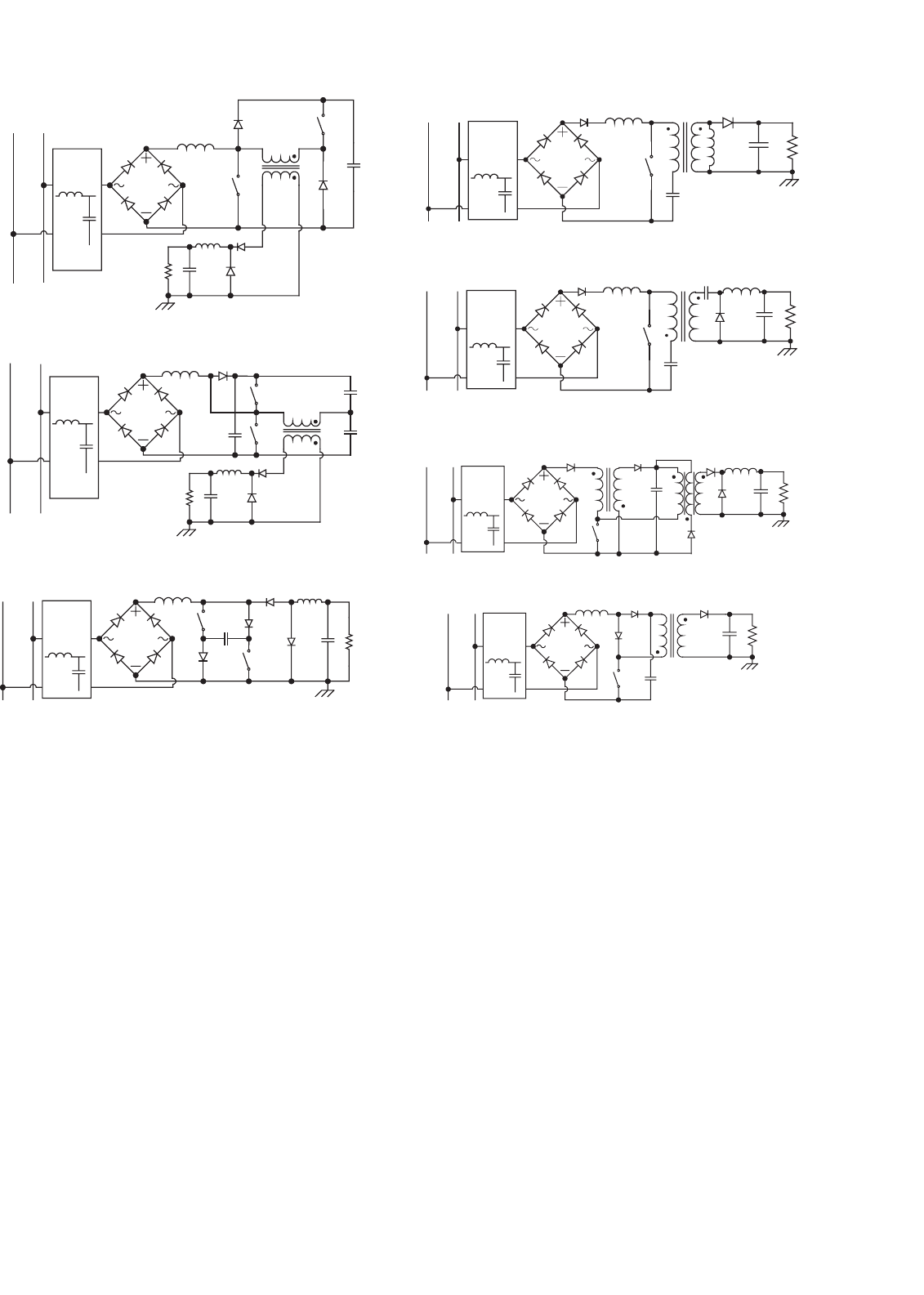
19 Power Factor Correction Circuits 537
Line
L
1
S
1
T
C
D
1
n : 1
D
2
S
2
L
2
C
o
D
o1
D
o2
Line
filter
(a)
(b)
Line
L
1
L
2
S
1
+
_
C
o
D
1
D
o1
R
L
D
o2
S
2
C
D
2
Line
filter
(c)
Line
L
1
L
2
S
1
T
C
o
D
1
D
o1
n : 1
C
2
D
o2
S
2
C
1
C
Line
filter
+
R
L
_
V
o
+
R
L
_
V
o
V
o
FIGURE 19.34 Two-switch single-stage power factor corrector:
(a) boost–forward converter; (b) boost-half bridge converter; and
(c) Sheppard–Taylor converter.
19.5.3 Other PFC Techniques
Extensive research in PFC continues to yield countless new
techniques [15, 53–63]. The research topics are mainly focused
on improvements of the PFC circuit performs such as fast per-
forms, high efficiency, low cost, small input current distortion,
and output ripple. The classification of PFC techniques pre-
sented here can only cover those methods that are frequently
documented in the open literature. There are still many PFC
methods which do not fall into the specified categories. The
following are some examples:
• Second-harmonic-injected method [56]: In DCM input
technique, even the converter operates at constant duty
ratio, current distortion still exists. The basic idea of
second-harmonic-injected method is compensating the
L
1
L
2
C
o
S
T
+
V
o
_
C
1
D
1
D
o
R
L
n : 1
Line
Line
filter
(a)
L
1
L
2
S
T
+
V
o
_
C
o
C
1
D
1
D
o
R
L
n : 1
C
2
Line
Line
filter
(b)
L
o
S
1: n1
+
V
o
_
C
o
C
1
D
1
D
o
R
L
1:n2 :n3
D
4
T
1
T
2
D
2
D
3
Line
L
S
T
+
V
o
_
C
o
C
D
1
D
o
R
L
n : 1
D
2
Line
Line
filter
Line
filter
(c)
(d)
FIGURE 19.35 Single-stage single-switch PFC circuit: (a) boost–flyback
combination circuit (BIFRED); (b) boost–buck combination circuit
(BIBRED); (c) flyback–forward combination; and (d) boost–flyback
combination.
duty ratio by injecting a certain amount of second har-
monic into the duty ratio to modify the input I–V
characteristic of the input converter. However, the output
voltage may be affected by the modified duty ratio.
• Interleaved method [57]: An interleaved PFC circuit
composed of several input converters in parallel. The
peak input current of these converters follow the line
voltage and are interleaved. A sinusoidal total line cur-
rent is obtained by superimposing all the input current of
the converters. The advantage of this method is that the
converter input current can be easily smoothed by input
EMI filter.
• Waveform synthesis method [58]: This method combines
passive and active PFC techniques. Since the rectifier in
the passive inductive-input PF corrector has a limited
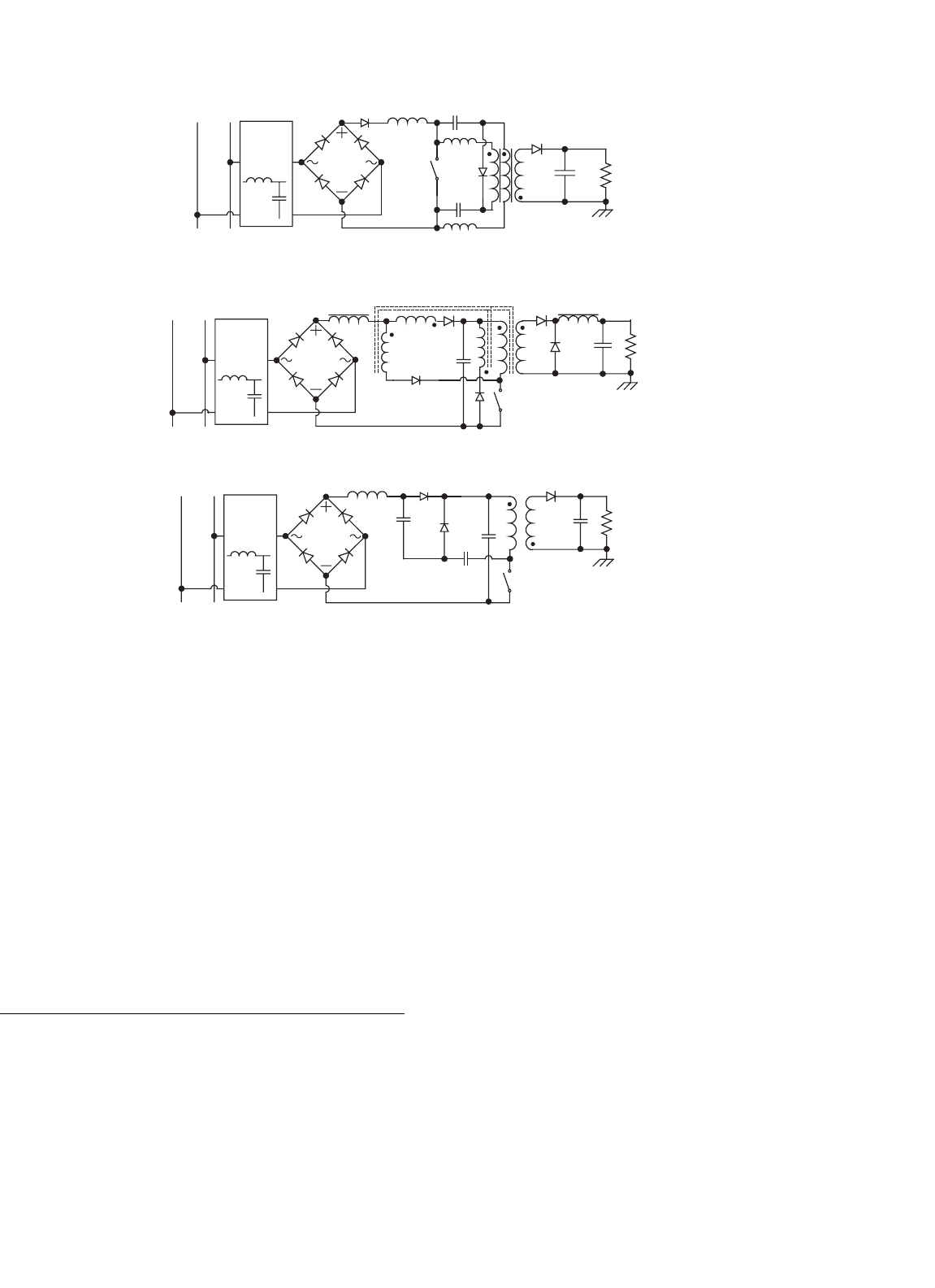
538 I. Batarseh and H. Wei
L
L
1
S
C
o
C
1
D
1
D
o
R
L
n: n : 1
L
2
C
2
T
Line
Line
filter
(a)
(b)
S
C
o
C
B
D
s
D
f
R
L
D
x
T
L
r
C
s
C
r
Line
Line
filter
(c)
L
F
S
C
F
C
B
D
1
D
FW
R
L
D
2
T
1
DD
R
L
B
N
2
N
1
N
R
N
p
N
s
Line
Line
filter
D
R
+
_
V
o
+
_
V
o
+
_
V
o
FIGURE 19.36 Improved S
4
-PFC converter: (a) boost–forward PFC circuit using two bulk capacitors; (b) boost–forward PFC circuit with reduced
bus voltage; and (c) boost–flyback PFC circuit with charge pump circuit.
conduction angle, the input current is a single pulse
around the peak of the line voltage, whereas the boost
converter draws a non-zero current around the zero-
cross of the line voltage. By controlling the operation
mode of the active switch (enable and disable the boost
converter at certain line voltage), the waveforms of active
and passive PFC circuits are tailored to extend the con-
duction angle of the rectifier. The resulting current
waveform has a PF greater than 0.9 and a THD lower
than 20%.
19.6 Summary
To reduce losses, and decrease weight and size associated with
converting ac power to dc power in linear power supply, switch
mode power supplies (SMPSs) were introduced. The high non-
linearity of this kind of power electronic systems handicaps
itself by providing the utility power system with low power
factor (PF) and high total harmonic distortion (THD). These
unwanted harmonics are commonly corrected by incorporat-
ing power factor correction (PFC) technique into the SMPS.
This chapter gives a technical review of current research in
high frequency PFC, including the definition of PF and THD,
configuration of PFC circuit, DCM input technique, and CCM
shaping technique. The common issue of these techniques is
to properly process the power flow so that the constant power
dissipation at the output is reflected into ac power dissipation
with two times the line frequency. Technically, PFC techniques
encounter the following tradeoffs:
(a) Simplicity and accuracy: Single-stage PFC circuit has
simple topology and simple control circuit, but has less
control accuracy while two-stage PFC circuit has the
contrary performance;
(b) Control simplicity and power handling capability:
DCM input technique requires no input current con-
trol, but has less power handling capability while CCM
has multiloop control and has more power handling
capability;
(c) Switching frequency and conversion efficiency:To
reduce weight and size of the PFC converter, higher

19 Power Factor Correction Circuits 539
switching frequency is desired. However, the associ-
ated switching losses result in decrease in conversion
efficiency;
(d) Frequency response and bandwidth: To have good
dynamic response, wider bandwidth is desired, however
to achieve high PF bulk storage capacitor and output
capacitor has to be used.
In the past decades, research in PFC techniques has led to
the development of more efficient circuits and control strate-
gies in order to optimize the design without compromising
the above tradeoffs. Moreover, since the growth in power elec-
tronics strongly relies on the development of semiconductor
devices, the recent advent of higher rating power devices, it
is believed that the switching mode PF correctors will com-
pletely replace the existing passive reactive compensators in
power system. In the distributed power system (DPS) where
small size and high efficiency are of extreme importance,
a new soft-switching technique has been used in designing
PFC circuits. With the ever increasing market demanding for
ultra-fast computer, the need for low output voltage (typically
less than 1 V!) with high output currents and high efficiency
converters has never been greater. Research efforts in develop-
ing high frequency high efficiency PFC circuits will continue
to grow.
Acknowledgment
I would like to thank my doctoral students Guangyong Zhu,
Shiguo Luo, and Wenkai Wu for their valuable contribution to
the area of power factor correction.
Further Reading
1. C. K. Duffey and R. P. Stratford, “Update of Harmonic Standard
IEEE-519: IEEE Recommended Practices and Requirements for Har-
monic Control in Electric Power Systems,” IEEE Trans. on Industry
Applications, vol. 25, no. 6, Nov. 1989, pp. 1025–1034.
2. B. K. Bose, “Power Electronics – A Technology Review,” Proceedings
of the IEEE, Aug. 1992, pp. 1303–1334.
3. H. Akagi, “Trends in Active Power Line Conditioners,” IEEE Trans.
on Power Electronics, vol. 9, no. 3, May 1994, pp. 263–268.
4. W. McMurray, “Power Electronics in The 1990’s,” Proceedings of
IEEE-IECON’90, pp. 839–843.
5. A. McEachern, W. M. Grady, W. A. Moncrief, G. T. Heydt, and
M. McGranaghan, “Revenue and Harmonics: An Evaluation of Some
Proposed Rate Structures,” IEEE Trans. on Power Delivery, vol. 10,
no. 1, Jan. 1995, pp. 474–480.
6. R. Redl, P. Tenti, and J. D. Van WYK, “Power Electronics’ Polluting
Effects,” IEEE Spectrum, May 1997, pp. 32–39.
7. J. S. Lai, D. Hurst, and T. Key, “Switch-Mode Power Supply
Power Factor Improvement Via Harmonic Elimination Methods,”
Conference Record of IEEE-APEC’91, pp. 415–422.
8. IEEE Inc., “IEEE Guide for Harmonic Control and Reactive Compen-
sation of Static Power Converters (IEEE Std. 519-1981),” ANSI/IEEE
Inc., 1981.
9. IEEE Inc., “IEEE Recommended Practices and Requirements for Har-
monic Control in Electrical Power systems (IEEE Std. 519-1992),”
ANSI/IEEE Inc., 1993.
10. I. Batarseh, “Power Electronic Circuits,” John Wiley & Sons Inc.,
(in press).
11. R. E. Tarter, “Solid-State Power Conversion Handbook,” John Wiley
& Sons Inc., 1993.
12. V. Vorperian, “Simplified Analysis of PWM Converters Using the
Model of the PWM Switch: Parts I and II,” IEEE Trans. on Aerospace
and Electronic Systems, vol. 26, no. 3, 1990, pp. 490–505.
13. M. O. Eissa, S. B. Leeb, G. C. Verghese, and A. M. Stankovic, “A Fast
Analog Controller for a Unity-Power-Factor AC/DC Converter,”
Conference Record of APEC’94, pp. 551–555.
14. R. Liu, I. Batarseh, and C. Q. Lee, “Resonant Power Factor Correction
Circuits with Resonant Capacitor-Voltage and Inductor-Current-
Programmed Controls,” Conference Record of IEEE-APEC’93,
pp. 675–680.
15. Y. Jiang and F. C. Lee, “Single-Stage Single-Phase Parallel Power
Factor Correction Scheme,” Conference Record IEEE-PESC’94,
pp. 1145–1151.
16. L. Dixon, “Average Current Mode Control of Switching Power
Supplies,” Product & Applications Handbook, Unitrode Integrated
Circuits Corporation, U140, 1993–94, pp. 9-457–9-470.
17. L. Dixon, “High Power Factor Switching Preregulator Design Opti-
mization,” Unitrode Power Supply Design Seminar, Sem-1000, 1994,
pp. I3-1–I-12.
18. J. P. Noon and D. Dalal, “Practical Design Issues for PFC Circuits,”
Conference Record of APEC’97, pp. 51–58.
19. B. Mammano, “Average Current-Mode Control Provides Enhanced
Performance for a Broad Range of Power Topologies,” PCIM’92-
Power Conversion, Sep. 1992, pp. 205–213.
20. J. P. Gegner and C. Q. Lee, “Linear Peak Current Mode Control: A
Simple Active Power Factor Correction Control Technique for Con-
tinuous Conduction Mode,” Conference Record of IEEE-PESC’96,
1996, pp. 196–202.
21. R. Redl and B. P. Erisman, “Reducing Distortion in Peak-Current-
Controlled Boost Power-Factor Corrector,” Conference Record of
IEEE-APEC’94, pp. 576–583.
22. C. A. Caneson and I. Barbi, “Analysis and Design of Constant-
Frequency Peak-Current-Controlled High-Power-Factor Boost Rec-
tifier with Slope Compensation,” Conference Record of IEEE-
APEC’96, pp. 807–813.
23. A. R. Prasad, P. D. Ziogas, and S. Manias, “A New Active Power
Factor Correction Method for Single-Phase Buck-Boost AC-DC
Converter,” Conference Record of IEEE-APEC’92, pp. 814–820.
24. A. V. Costa, C. H. G. Treviso, and L. C. Freitas, “A New ZCS-
ZVS-PWM Boost Converter with Unit Power Factor Operation,”
Conference Record of IEEE-APEC’94, pp. 404–410.
25. J. Mahdavi, M. Tabandeh, and A. K. Shahriari, “Comparison
of Conducted RFI Emission from Different Unity Power Fac-
tor AC/DC Converters,” Conference Record of IEEE-PESC’96,
pp. 1979–1985.
26. J. C. Salmon, “Techniques for Minimizing the Input Current
Distortion of Current-Controlled Single-Phase Boost Rectifiers,”
IEEE Trans. on Power Electronics, vol. 8, no. 4, Oct. 1993,
pp. 509–520.
